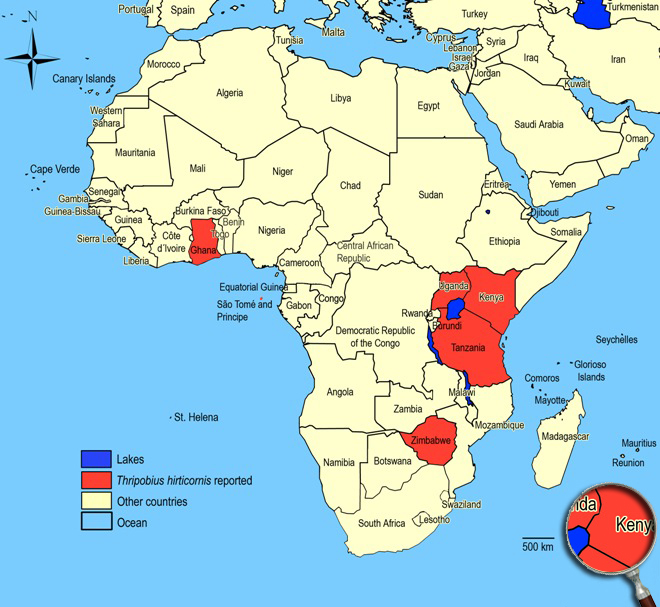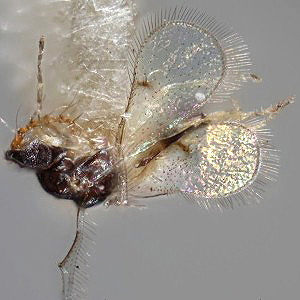Thripobius hirticornis Ferrière, 1938
Entedoninae, Eulophidae, Chalcidoidea, Hymenoptera
Figures
Fig. 1: Head, mesosoma and metasomalateral
Fig. 2: Antenna
Fig. 3: Funicle segment F1 with a long sensillum and pedicel
Fig. 4: Head and mesosoma lateral
Fig. 5: Fore wing
Fig. 6: Stigmal vein of fore wing
Fig. 7: Bicoloured abdomen covered by the fore wings
Introduction and recognition
Thripobius hirticornisis a larval endoparasitoid of the thrips Retithrips syriacus (subfamily Panchaetothripinae; family Thripidae). Female: length <1 mm. Head and mesosoma dark brown; antennae and legs yellow (Fig. 1); gaster yellow basally and dark brown on posterior half. On head vertexal suture complete and straight; frontal groove extending to top of eye or beyond to occipital suture; malar sulcus split ventrally (Y-shaped). Antenna with scape slightly broadened medially, about 4-5 x as long as wide; 2 funicle segments subequal and not appressed, F1 and F2 markedly longer than broad; F1 with a long sensillum, F2 without a sensillum; flagellar segments with several very long sensilla and setae sticking out far beyond the segment bearing them; 3-segmented clava (division distinct) about 5 x as long as wide, with a very short apical spicula (Fig. 2, 3 and 4). Mesosoma shorter than gaster, almost smooth; midlobe of mesoscutum without setae;anterior margin of scutellum straight. Fore wing broadened beyond submarginal vein, about 3 x as long as wide; longest marginal setae about 1/3 maximal width of fore wing; disc hyaline with numerous short setae with a brown marking just below the stigmal vein (Fig. 6), more or less uniformly setose beyond base of marginal vein except for a distinct semi-oval bare area at posterior margin behind base of marginal vein, which is demarcated anteriorly by a sinuate line of setae; postmarginal vein minute, shorter than stigmal vein (Fig. 5). Hind wing about 8-9 x as long as wide (Fig. 1). Petiole wider than long.
Male similar to female, but more slender and setae on male antennal flagellum are longer than on female’s.
Taxonomic identity
Species
Thripobius hirticornis Ferrière, 1938
Taxonomic history
-
Present taxonomic position
Order: Hymenoptera
Superfamily: Chalcidoidea Latreille, 1817
Family: Eulophidae Westwood, 1829
Subfamily: Entedoninae Förster, 1856
Genus: Thripobius Ferrière, 1938
Genus description
The GenusThripobius Ferrière, 1938
This genus comprises 4 described species. All known species of Thripobius are solitary, internal parasitoids of the larval stages of various Panchaetothripinae (Thripidae, Terebrantia), and have a Palearctic, tropical or subtropical (Africa, Australia, India, Indonesia, South America) distribution. All species of this genus have the following features: Head usually with a complete and straight suture present across vertex just behind posterior ocelli; frontal groove extending to top of eye or beyond to occipital suture; malar sulcus present, split ventrally (Y-shaped); mandible reduced and without teeth; antennal flagellum in both sexes with 2 funicle segments (usually appressed to each other) and a 3-segmented clava with an apical spicula (division between second and third claval segments often indistinct), flagellar segments with long sensilla and setae; notauli usually indistinct; midlobe of mesoscutum usually with 1 pair of setae, but asetose in the type species of the genus, T. hirticornis; anterior margin of scutellum almost straight or slightly sinuate; fore wings broadened beyond submarginal vein, longest marginal setae at most equal to (usually much less than) width of fore wing; fore wing disc with bare area at posterior margin behind base of marginal vein, demarcated anteriorly by a sinuate line of setae; petiole wider than long, present only dorsally as a narrow sclerotized band (Schauff 1991; Triapitsyn 2005). Triapitsyn (2005) gave a world taxonomic revision of Thripobius and three other related entedonine genera of thrips parasitoids, and Loomans & van Lenteren (1995) provided an overview of the described thrips parasitoids and their importance for biological control of thrips pests.
Species description
Typical character states of Thripobius hirticornis
Body colour
Bicoloured
Antennae
Funicle segments F1 and F2: subequal
Sensilla of funicle segments: F1 with 1 long sensillum, F2 without a sensillum
Length of funicle segments: markedly longer than wide
Clava of female: 3-segmented
Apical spicula of clava: present
Head
Vertexal suture: straight
Frontal grooves: reaching eyes above level of median ocellus, sometimes ending in vertexal suture
Mesosoma
Number of setal pairs on midlobe of mesoscutum: 0
Anterior margin of scutellum: straight or slightly curved
Wings
Shape of fore wing: broadened beyond submarginal vein
Length of fore wing: 2.4 to 3.0 x as long as wide
Length of fore wing marginal setae: usually much less than width of fore wing
Longest marginal setae of fore wing: 1/4 to 1/3 maximal width of fore wing
Fore wing disc: more or less uniformly setose beyond base of marginal vein except for a distinct semi-oval bare area at posterior margin behind base of marginal vein, which is demarcated anteriorly by a sinuate setal line
Colour of fore wing disc: hyaline with a small dark cloud below apex of stigmal vein or completely hyaline, without pigmentation
Metasoma
Colour of gaster: distinctly bicoloured, basally yellow and distally brown
Petiole: notably and about 2 x wider than long

Similar or related species
The species differs from Thripobius javae in having the antennal funicle segments F1 & F2 markedly longer than wide, the midlobe of mesoscutum without setae, the longest marginal setae of fore wing only about 1/3 maximal width of fore wing, and a gaster which is yellow basally and dark brown at posterior half. Whereas in Thripobius javae the antennal funicle segments F1 & F2 are about as long as wide, the midlobe of mesoscutum has 1 pair of setae, the longest marginal setae of fore wing have 1/2 maximal width of fore wing, and the gaster is completely yellow with few brown markings sublaterally.
Thripobius and other genera differs from Goetheana by the shape of the antennal funicle segments (in Goetheana funicle segment F1 much smaller than F2, F2 almost fused with clava; in other genera the funicle segments F1 and F2 are subequal), the shape of the fore wing (narrow and recurved below the submarginal vein in Goetheana; species of the genera Entedonomphale, Ceranisus and Thripobius with fore wings broadened beyond submarginal vein), and the length of marginal seta of fore wing (in Goetheana the longest marginal setae much greater than width of fore wing; other genera with longest marginal setae at most equal to width of fore wing, but usually much less than width of fore wing). The chaetotaxy of the fore wing disc differs among the genera: in Goetheana the setae commencing beyond base of marginal vein and scattered in 2 or 3 broken rows toward the apex of the wing, in Entedonomphale the fore wing is evenly setose in apical half and bare in basal half, and in Ceranisus and Thripobius the fore wing is uniformly setose beyond base of marginal vein except for a bare area at posterior margin behind base of marginal vein, which is demarcated anteriorly by a sinuate or straight line of setae. Compared to Entedonomphale, species of Ceranisus and Thripobius have the antennal clava of females distinctly segmented (Thripobius with 3-segmented and Ceranisus with 2-segmented clava), and the apical spicula of clava ist present. Whereas in Entedonomphale the antennal clava of females is unsegmented and without apical spicula. Entedonomphale as well as Thripobius have an inverted Y-shaped malar sutures (in Ceranisus entire and straight). Compared to species of Ceranisus, in Thripobius antennal funicle segments F1 has 1 long sensillum, F2 no sensillum, on head the malar sulcus is splited ventrally, the frontal grooves reach eyes above level of median ocellus, sometimes ending in vertexal suture, the midlobe of mesoscutum has 0 or 1 pair of setae. Whereas in Ceranisus each antennal funicle segment has 1 or 2 short sensilla, on head malar sulcus is entire and straight, the frontal grooves reach eyes at level of anterior (median) ocellus, the midlobe of mesoscutum has 2 pairs of setae.
Biology
Life history
Thripobius hirticornis reproduces parthenogenetically, is arrhenotokous and biparental (Ferrière 1938; Loomans & van Lenteren 1995).
Major host genera/species
Thripobius hirticornis is only known to parasitize Retithrips syriacus on crops such as coffee and rose.
Biological control
Not frequently observed.
Additional notes
-
Biogeography
East Africa, Indonesia. Ghana, Kenya, Tanzania, Uganda, Zimbabwe.
African countries where Thripobius hirticornis has been reported

The species Thripobius hirticornis was not observed in surveys undertaken in East Africa on vegetables and associated weeds and crops.
Please click here for survey sites of all observed thrips species of Kenya, Tanzania and Uganda.

Bibliography
Bouček Z (1976). Taxonomic studies on some Eulophidae [Hym.] of economic interest mainly from Africa. Entomophaga. 21 (4): 401-414
Ferrière C (1938). Descriptions of some African Eulophidae (Hym. Chalc.). Bulletin of Entomological Research. 29 (2): 141-147
Gibson, G.A.P., Read, J.D. & Fairchild, R. 1998. Chalcid wasps (Chalcidoidea): illustrated glossary of positional and morphological terms
Herting B (1971). Arachnida to Heteroptera. A catalogue of parasites and predators of terrestrial arthropods. Section A. Host or Prey / Enemy. 1. Commonwealth Agricultural Bureaux, Slough, England, 129 pp
Loomans AJM, Murai T & Green ID (1997). Interactions with hymenopterous parasitoids and parasitic nematodes, pp. 355-397. In Lewis T [ed.], Thrips as crop pests. CAB International, Wallingford, Oxon, UK
Loomans AJM & van Lenteren JC (1995). Biological control of thrips pests: a review on thrips parasitoids, pp. 89-201. In Loomans AJM, van Lenteren JC, Tommasini MG, Maini S & Riudavets J [eds.], Biological control of thrips pests. Wageningen Agricultural University Papers, 95-1. Veenman Drukkers, Wageningen, The Netherlands
Ritchie AH (1932). Report of the entomologist, 1931. Annual Report. Tanganyika Territory, Department of Agriculture. 1931: 83-86
Ritchie AH (1933). Report of the entomologist, 1932. Annual Report. Tanganyika Territory, Department of Agriculture. 1932: 68-72
Schauff M (1991). The Holarctic genera of Entedoninae (Hymenoptera: Eulophidae). Contributions of the American Entomological Institute. 26 (4): 1-109
Triapitsyn SV (2005). Revision of Ceranisus and the related thrips-attacking entedonine genera (Hymenoptera: Eulophidae) of the world. African Invertebrates. 46: 261-315
----
Web links
BMNH, Universal Chalcidoidea Database
UC Riverside - Key to the Nearctic genera of Eulophidae
Mound´s Thysanoptera pages
Thysanoptera Checklist
ICIPE Thrips survey sites
UNI Halle & Thrips sites
Thrips of California
Chalcid wasps (Chalcidoidea): illustrated glossary of positional and morphological terms
Assembling the Tree of Life - Hymenopera Glossary










